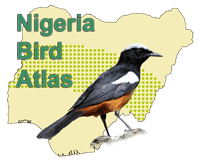The Nigeria Bird Atlas Project (NiBAP) started at the end of 2015 as an initiative of the A. P. Leventis Ornithological Research Institute (APLORI), Jos, Nigeria with technical support from the Animal Demography Unit (ADU), University of Cape Town, South Africa. The project aims to engage volunteer members of the Nigerian public to collect and update information on the distribution of birds to be published in a bird atlas for Nigeria and in the process increase public awareness about biodiversity and environmental conservation in Nigeria.
With initial funding grant from ScandinavKonsult, Sweden and BirdLife Sweden, the APLORI Atlas team including a project coordinator, a manager, and one project assistant was set up to kick off the project in December 2015. This team was given the mandate to carry out dedicated atlasing around the country to survey as many areas as possible and to recruit volunteers for the project. In 2017, two new members were recruited to the project team to assist and facilitate communication with the growing volunteer base for the project.
The Nigerian Bird Atlas Project adopts the ongoing Southern Africa Bird Atlas Project (SABAP2) protocol which has also been adopted in Kenya and recently launched as the protocol to use across all of Africa. This protocol involves a dedicated minimum of two hours of watching and recording of birds within a pentad. A pentad is the basic sampling unit of the grid system which is based on the coordinate system and which has been developed for all of Africa.
The pentad measures 5ʹ x 5ʹ of latitude and longitude respectively and there are about 11,141 pentads across Nigeria. Bird lists are submitted via the project web portal [http://nigeriabirdatlas.adu.org.za] or in real-time using the dedicated mobile phone app – BirdLasser – which are readily downloadable from the Google Play Store and iOS Apple App Store.
